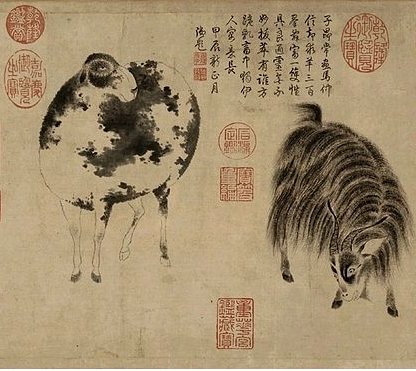7. In spring hunger must be pushed away, whether personified as 'She who makes food scarce' (Whaka-onge-kai, see at Ruhi) or as 'the Goat'. The long hair of goats is a sign which means winter. She needs this long hair in order to keep warm.
(Cfr at Auriga and at Lupus.) The onset of the new season is announced by the arrival of birds: "In Libya the year begins in the autumn with the winter rains and the arrival of birds from the North; but in Northern Europe and the Black Sea area it begins in Spring with the arrival of birds from the South. In most Greek states the year began in the autumn and the Greek augurs faced north when observing birds, presumably because they derived their tradition from the birth-place of Athene, patroness of augury. On the other hand, the Roman augurs faced south, presumably because the Dardanians (whose patrician descendants in the early Roman Republic were alone permitted to take auguries) had migrated from the Black Sea area where birds arrive from Palestine and Syria in the Spring. The Roman year began in the Spring. The goat-Dionysus, or Pan, was a powerful deity in Palestine. He may have come there from Libya by way of Egypt or taken a roundabout northern route by way of Crete, Thrace, Asia Minor and Syria. The Day of Atonement scape-goat was a left-handed sacrifice to him under the name of Azazel, and the source of the Jordan was a grotto sacred to him as Baal Gad, the goat king, eponymous ancestor of the tribe of Gad." (The White Goddess) According to the G text birds (Ga5-8) arrived in spring (in 'September) and this is half a year later than the 'March equinox:
From Algenib Pegasi to Omikron Virginis there are 180 days. From Rogo in Gb6-26 to Rogo at left (in the past) in Ga5-10 there are 184 days. Presumably it means the Rogo type of glyph refers to spring equinox north of the equator. The Hawaiian new year was connected with the rebirth of nature brought by the return of Sun. Furthermore the net of 'Lady Godiva' was present at that time too, promising a time with plenty to eat: ... in the ceremonial course of the coming year, the king is symbolically transposed toward the Lono pole of Hawaiian divinity ... It need only be noticed that the renewal of kingship at the climax of the Makahiki coincides with the rebirth of nature. For in the ideal ritual calendar, the kali'i battle follows the autumnal appearance of the Pleiades, by thirty-three days - thus precisely, in the late eighteenth century, 21 December, the winter solstice. The king returns to power with the sun. Whereas, over the next two days, Lono plays the part of the sacrifice. The Makahiki effigy is dismantled and hidden away in a rite watched over by the king's 'living god', Kahoali'i or 'The-Companion-of-the-King', the one who is also known as 'Death-is-Near' (Koke-na-make). Close kinsman of the king as his ceremonial double, Kahoali'i swallows the eye of the victim in ceremonies of human sacrifice ... The 'living god', moreover, passes the night prior to the dismemberment of Lono in a temporary house called 'the net house of Kahoali'i', set up before the temple structure where the image sleeps. In the myth pertinent to these rites, the trickster hero - whose father has the same name (Kuuka'ohi'alaki) as the Kuu-image of the temple - uses a certain 'net of Maoloha' to encircle a house, entrapping the goddess Haumea; whereas, Haumea (or Papa) is also a version of La'ila'i, the archetypal fertile woman, and the net used to entangle her had belonged to one Makali'i, 'Pleiades'. Just so, the succeeding Makahiki ceremony, following upon the putting away of the god, is called 'the net of Maoloha', and represents the gains in fertility accruing to the people from the victory over Lono. A large, loose-mesh net, filled with all kinds of food, is shaken at a priest's command. Fallen to earth, and to man's lot, the food is the augury of the coming year. The fertility of nature thus taken by humanity, a tribute-canoe of offerings to Lono is set adrift for Kahiki, homeland of the gods. The New Year draws to a close. At the next full moon, a man (a tabu transgressor) will be caught by Kahoali'i and sacrificed. Soon after the houses and standing images of the temple will be rebuilt: consecrated - with more human sacrifices - to the rites of Kuu and the projects of the king ... |




